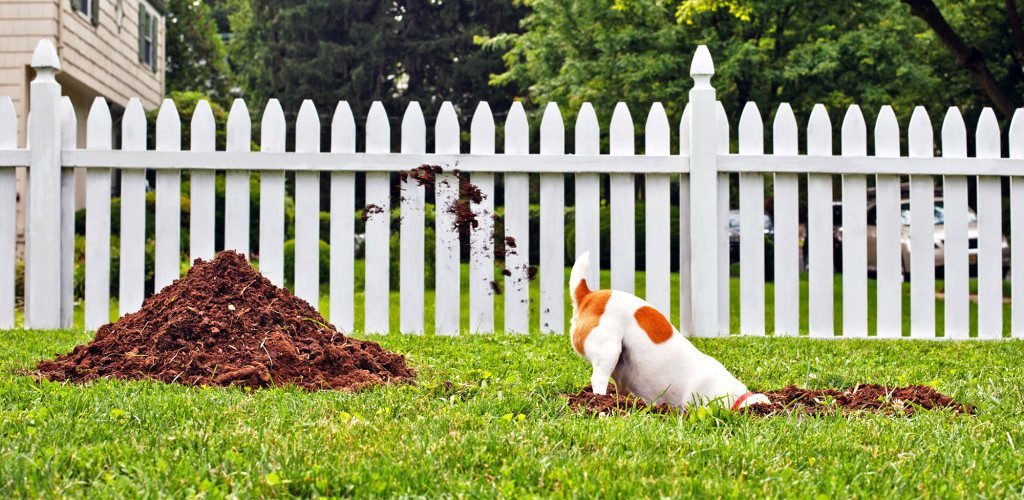Chickens & Ducks are excellent at cleaning up unwanted snails and bugs, altho’ they can be over-enthusiastic when it comes to turning over mulch.
The days are getting longer, slowly getting warmer and I’ve had to mow twice in a fortnight. Spring is in the air! The first sign of blue sky will usually see me out in my garden. I find it peaceful to wander around weeding here and there, good for the soul the odd bit of pruning, and one can be quite philosophical watching a pile of dead debris slowly burn. My dogs enjoy having me outside, as do the goats and chooks.
But how does one balance having a well-cared for garden, when your companions are crashing through your native shrubs, digging holes in flower beds and weeing on any plant – not just the lemon tree! Let alone how much mulch chooks can excavate when you’re not looking, and as for how quickly a goat will strip a fruit tree …..
Be clear about how you want your dog to behave in the garden. Set the ground rules for your dog from the start. As with people, pet habits once established, can be a challenge to change. Remember that bored dogs are most likely to get into themselves trouble. Walk or play games to use up excess energy that might otherwise go into destructive behavior. Decide where your dog is allowed to go and where you don’t want him to go. Be consistent. It doesn’t help if you let the dog do what he wants when the flowerbed is weedy, but then expect him to respect the garden when it’s all tidied up.
A pet-friendly garden design will include some creature comforts for your mates too – like a shady place to lay on a hot day. Remembering to put their water bowl in a cool place – close to a tap is always handy. Features may include –
A designated digging pit: If digging is a problem, the most pet-friendly garden solution is to set up a special area just for them with a digging pit filled with sand.
Shady observation deck: dogs like to sit in a place where they can keep an eye on the whole garden, so offer them a large, shady area to sit/lay and observe.
Wading pool: a pool just for your dog can be a great way to help keep them cool during hot summer days. I have one of those shells used as childrens sandpit set up on bricks and filled with water.
Toys and activities: if your dog likes to chew, offer them a safe alternative to your reticulation that helps to stimulate their mind, like a Kong toy, treat ball or treasure hunt.
Decide where your dog is allowed to go and where you don’t want him to go. Be consistent. It doesn’t help if you let the dog do what he wants when the flowerbed is weedy, but then expect him to respect the garden when it’s all tidied up.
Dogs and lawns: A Separate toilet area will help to avoid urine marks on the lawn, create a special area with wood chips or gravel as a surface, and screen it from view with a trellis fence or informal grouping of shrubs. Dogs tend to want to do their toilet on an absorbent surface. The younger you train your dog, the easier it will be. Male dogs respond well to a ‘lift-your-leg-here’ post in the ground, which helps prevent damage to shrubs and young trees.
Clean up often. Remove poo and run a sprinkler occasionally to wash away odors and dog urine on lawns. A dog will start avoiding the toilet area if it’s soiled. Plus – there’s nothing worse than having to clean up a winter’s worth of dog droppings in early spring. Put dog feces in the garbage. Don’t add to your compost pile, as it could contain worm eggs or other hazards.
Fencing: If you have a dog, your pet-friendly garden needs a solid fence. 1.2 metres is a good height, altho’ for some athletic dogs fences will need to be 1.5-1.8 metres high. Avoid large gaps between the fence and the ground for canine escape artists looking to dig their way out.
Paths: Like people, pets make a beeline to where they want to go. If your dog wears a dirt trail into the lawn, install a permanent path with pavers or stepping-stones. In small gardens, playful dogs can easily disturb paths of mulch – brick or stone are easier to maintain.
Plants: When adding new plantings, larger-sized shrubs and trees and perennials are more likely to earn your pets respect than little sticks that look like chew toy. If you have sensitive plants or planting area just getting established, try a temporary wire enclosure to keep pets out.
Mass planting: Most will go around rather than through massing shrubs or ornamental grasses. Grasses are particularly tough plants that are unlikely to be injured by the most boisterous of dogs.
Soil: Try to avoid having bare soil – it’s a perfect invitation to dogs to dig. Plant perennials close together, and choose tough pet-friendly plants – eg: use ground covers like thyme between larger woody plants.
Mulch: Use inorganic mulch where appropriate. If you’re trying to get a new area of lawn to grow, sod is quicker to establish than seed, especially with pets using the yard.
Vegetable gardens: Use straw mulch to cover the soil in between rows of vegetables or individual plants such as tomatoes.
When you have dogs or other pets in your garden, its vital to think in terms of their safety. Think about what you’re using as fertilisers, to get rid of bugs etc. Choose alternatives to chemicals for lawn and garden care.
Pest control products: Even if you use organic products, keep pets out of the garden when you’re applying them, and then keep them away from treated areas for as long as recommended, usually until the treated area is dry or 24 hours.
Snail/Slug baits: Pellets are often cereal based which unfortunately makes them attractive to dogs. The ones containing methiocarb or metaldehyde (often coloured blue or green) are toxic to pets if ingested in any quantity. Those advertised with a ‘bittering’ agent rarely deter dogs as they eat quickly and do not register the taste. A safer alternative are made with iron phosphate as the active ingredient.
Fertilisers: Many organic fertilisers are made out of bone meal, blood meal or fish emulsion, which can smell like dinner to a curious pet. Store these products, as well as conventional fertilisers inside containers with secure lids out of harms reach.
Sharp edged garden tools: Your dog (or yourself) could get injured if you leave a rake or hoe blade up or open pruners on the ground.
Plants to avoid in the garden: Here’s a short list of some of the common household plants that contain toxins. Including Azalea, Bird of Paradise, Ivy, Asparagus Fern, Oleander, Lilies, Foxgloves, Macadamia nuts, Wandering jew, Yew tree, and Poinsettias. They may cause a rash after contact with skin, irritation and swelling of the mouth, lips and tongue, or cause damage to organs.
Dogs like to be where people are, so when you’re in the garden, take your dog with you. If you put some effort into training, your dog will become a great companion within your pet-friendly garden, where they will safely be able to enjoy just being a dog.

